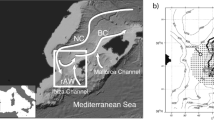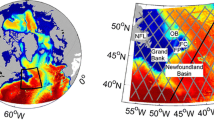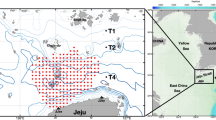Abstract
We examine velocity statistics from a numerical simulation of the Nordic Seas with 4 km resolution, with a focus on the Norwegian shelf and slope. The model mean flow is dominated by its version of the Norwegian Atlantic Current, with two branches, one near the shelfbreak and the other near the 2000 m isobath. The model variances are surface-intensified and increase with water depth over the shelf; the variance ellipses also indicate topographic steering. Seasonality is more pronounced on the shelf than on the slope and the velocity probability distributions are weakly non-Gaussian, reflecting an excess of extreme velocities. All these aspects are broadly consistent with the observations. There are, however, differences with the observations. The topographic steering of the mean flow and of the variance ellipses is less pronounced in the model, a probable consequence of the model bathymetry, etopo5, being too smooth. The temporal and spatial coherence scales are too large by about a factor of 2, probably due to the model resolution. And correlations between velocity time series from the model and in situ moorings are generally small, despite the model having realistic forcing. The low predictability presumably reflects the degree of chaos in the flow and highlights the need for data assimilation.

















Similar content being viewed by others
Notes
Due to the model’s polar stereographic grid, the grid separation varies from 3.7 km in the south to 4.3 km in the north.
Interestingly, the outer branch was not observed in the aforementioned MIPOM experiments (in which the outer domain was modeled with a 20 km grid); evidently the flow around Iceland was seriously degraded in the lower resolution model.
The apparent cross-isobath flow at S1 was found to be an artifact of mooring motion.
The observations suggest a mean flow offshore, but this probably reflects a discrepancy in the orientation between etopo5 and actual bathymetry.
The cross-isobath variance has been corrected to compensate for low-frequency velocity fluctuations due to the mooring motion noted earlier.
We de-mean individual records, normalize them by their respective standard deviations and then combine them with other records from a given region.
To evaluate the probability, we assume a 3-day integral time scale for the data.
References
Blumberg A, Mellor G (1987) A description of a three-dimensional coastal ocean circulation model Three-dimensional Coastal Ocean Models, vol 4 of Coastal and Estuarine Sciences. American Geophys. Union
Bracco A, LaCasce JH, Pasquero C, Provenzale A (2000) The velocity distribution of barotropic turbulence. 12:2478–2488
Engedahl H (1995) Implementation of the Princeton ocean model (POM/ECOM-3D) at the Norwegian Meteorological Institute (DNMI). Res Rep No 5, Norwegian Meteorological Institute
Engedahl H, Eriksrød G, Ulstad C, Adlandsvik B (1997) Climatological oceanographic archives covering the Nordic Seas and the adjacent Arctic ocean with adjacent waters. Res Rep No 59, Norwegian Meteorological Institute
Galperin B, Kanta LH, Hassid S, Rosati A (1988) A quasi-equilibrium turbulent energy model for geophysical flows. J Atmos Sci 45:55-62
Hackett B, Engedahl H (2000) Numerical model study of slope and deep water currents Phase iii: regional archive evaluation and Ormen Lange Hindcast. Res Rep No 93, Norwegian Meteorological Institute
Haney RL (1971) Surface thermal boundary conditions for ocean circulation models. J Phys Oceanogr 1:241–248
LaCasce JH (2005) Statistics of low frequency currents over the western Norwegian shelf and slope I: current meters. Ocean Dyn (submitted)
LaCasce JH, Brink KH (2000) Geostrophic turbulence over a slope. J Phys Oceanogr 30:1305–1324
Mauritzen C (1996) Production of dense overflow waters feeding the North Atlantic across the Greenland-Scotland Ridge Part 1: evidence for a revised circulation scheme. Deep-Sea Res I 43:769–806
Mellor GL, Yamada T (1982) Development of a turbulence closure model for geophysical fluid problems. Rev Geophys Space Phys 20:851–875
Orvik KA, Niiler P (2002) Major pathways of Atlantic Water in the northern North Atlantic and Nordic Seas toward Arctic. Geophys Res Lett 29(19):1896
Poulain PM, Warn-Varnas A, Niiler PP (1996) Near-surface circulation of the Nordic Seas as measured by Lagrangian drifters. J Geophys Res 101:18237–18258
Skagseth Ø, Orvik KA (2002) Identifying fluctuations in the Norwegian Atlantic Slope Current by means of empirical orthogonal functions. Cont Shelf Res 22:547–563
Acknowledgments
This work was supported under the Ormen Lange license by Norsk Hydro. Additional support for JHL were provided under the NOCLIM program, funded by the Norwegian Research Foundation. The in situ data was provided by the Norwegian Deep Water Program (NDP) and by K.A. Orvik of the University of Bergen. We appreciate the comments of two anonymous reviewers which helped improve the manuscript.
Author information
Authors and Affiliations
Corresponding author
Additional information
Responsible Editor: Phil Dyke
Rights and permissions
About this article
Cite this article
LaCasce, J.H., Engedahl, H. Statistics of low frequency currents over the western Norwegian shelf and slope II: Model. Ocean Dynamics 55, 222–237 (2005). https://doi.org/10.1007/s10236-005-0022-5
Received:
Accepted:
Published:
Issue Date:
DOI: https://doi.org/10.1007/s10236-005-0022-5




